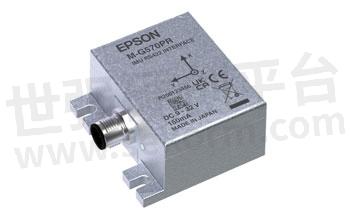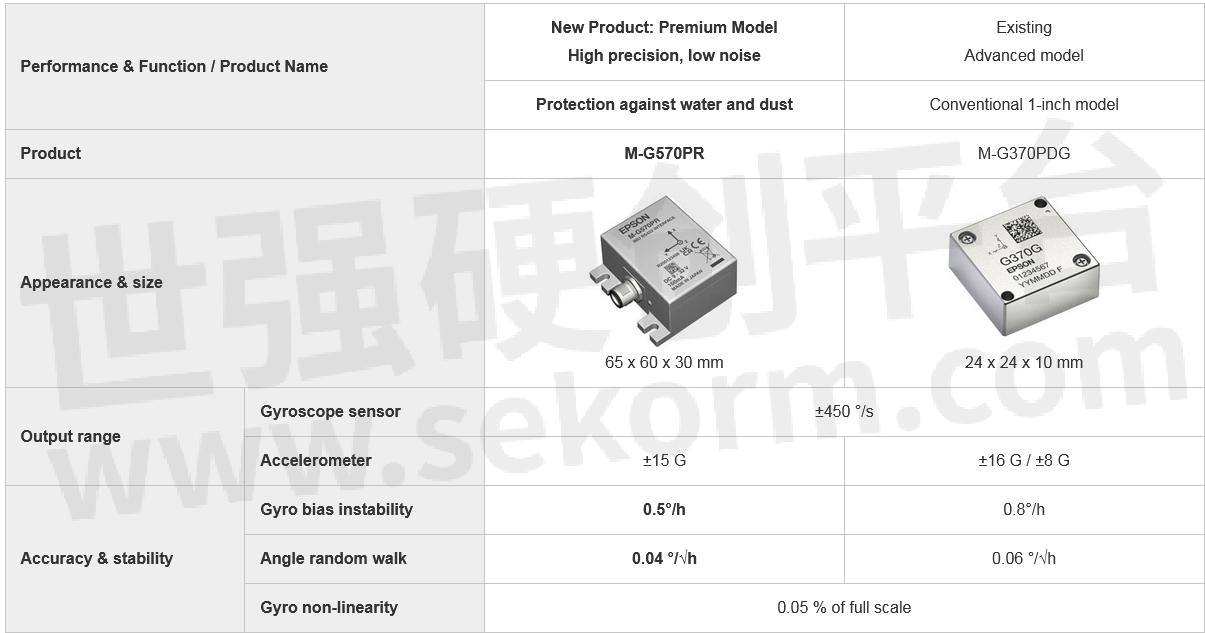Epson to Launch Mass Production of the M-G570PR, a High-precision, Low-noise IMU Enabled by Multi-sensor Technology

Seiko EPSON Corporation (TSE: 6724, "Epson") has developed and recently begun volume production of the new premium model for its lineup of inertial measurement units1 ("IMUs") equipped with high-performance six-axis sensors. The new model, the M-G570PR, offers high precision, low noise and an IP67 rating for protection against the intrusion of dust and water.

M-G570PR
Epson launched its first IMU with quartz crystal gyroscope sensors2 at its core in 2011. Since then, Epson's IMUs have been used in an array of customer applications, from precision agriculture (GNSS3), small satellites4 using consumer and industrial components, and EO/IR camera gimbals5 to antenna platform for vibration control and stabilization, earning an excellent reputation for outstanding performance and quality. In recent years, IMU use has expanded into fields such as surveying, or aerial and satellite video photography, creating a growing need for more accurate position and attitude control. Accordingly, demand is rising for IMUs that offer high-precision performance, which is crucial in attitude control.
The new M-G570PR is based on the existing M-G370PDG and uses Epson's proprietary multi-sensor technology to improve performance by combining multiple IMUs. This achieves gyro bias instability6 of 0.5°/h and angle random walk7 of 0.04°/√h, enabling more accurate measurement.
Packaged in an IP67-rated metal enclosure, the M-G570PR offers high-level of protection against the intrusion of dust and water. It also comes standard equipped with an RS-4228 serial communication interface, which is commonly used in the industrial field. This IMU can thus be used in a wide variety of industrial applications that require high stability and high reliability.
Given the social and technological changes that are underway, Epson believes that the need for precision sensors will only expand going forward. We will continue to leverage our philosophy of efficient, compact, and precise innovation to provide small, lightweight, low-power sensing systems that offer outstanding precision, high stability, and low noise to significantly contribute to our customers' products and services.
Product Features
0.5°/h gyro bias instability
0.04°/√h angle random walk
Gyroscope sensor non-linearity9 is 0.05% for the sensor's full scale range
IP67 rated, RS-422 interface, failure diagnosis function
Product Applications
Vibration control for EO/IR camera gimbals, antennas, small satellites that use consumer and industrial components, etc.
Navigation systems (GNSS, INS10, high-precision locators), etc.
Unmanned vehicles (industrial drones, terrestrial vehicles, sea probes, etc.)
Vibration, angle, trajectory measurement of industrial equipment, etc.
General Specifications of the M-G570PR and 1-Inch Platform Products


1 Inertial measurement unit (IMU)
An IMU is a device that is used for sensing inertial motion. It is comprised of triaxial angular rate sensors and triaxial accelerometers.
2 Gyroscope sensor (angular rate sensor)
3 A global navigation satellite system (GNSS)
A satellite system that is used to pinpoint a geographic location anywhere in the world
4 This product and other Epson IMUs do not conform to the standards for use in space.
5 EO/IR camera gimbal
An electro-optical, infrared camera system
6 Gyro bias instability
The part of the Allan variance that represents the horizontal (zero power) characteristic is called bias instability. It correlates with 1/f noise and is one of the important indicators of sensor potential.
(An indicator of sensor performance, the Allan variance indicates the stability of the static output. The horizontal axis shows the averaging time of data, and the vertical axis shows the distribution of the average value when separated by the average time. It is known that the sensor characteristics appear as slopes in the Allan variance at -1, -1/2, 0, 1/2, and 1st power slopes. Allan variance is an indicator expressed over averaging time. The smaller the value, the higher the stability and the better the performance.)
7 Angle random walk
The part of the root Allan variance with a slope of -1/2 is called the angle random walk and correlated with white noise.
8 RS-422
A standard for serial communication that is commonly used in industrial systems and other applications requiring reliable long-distance serial communication
9 INS
Inertial navigation system
Measures the rotation angle (angular rate) of an object versus a reference axis per unit of time.
10 Non-linearity
The maximum deviation from an approximate straight line of the output versus input of a gyroscope sensor or accelerometer. It is typically expressed as a percentage of the full scale.
- +1 Like
- Add to Favorites
Recommend
This document is provided by Sekorm Platform for VIP exclusive service. The copyright is owned by Sekorm. Without authorization, any medias, websites or individual are not allowed to reprint. When authorizing the reprint, the link of www.sekorm.com must be indicated.






















































































































































































































































































































































































































































































































































































































































































































































































































































































































